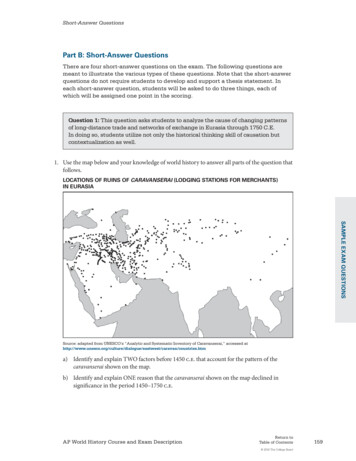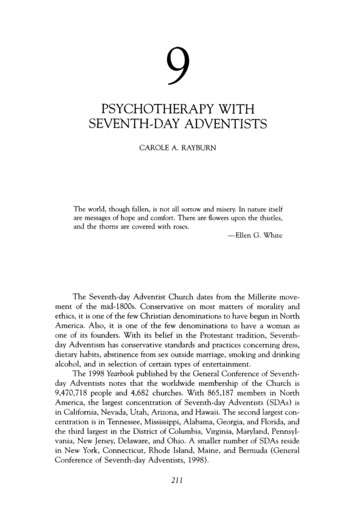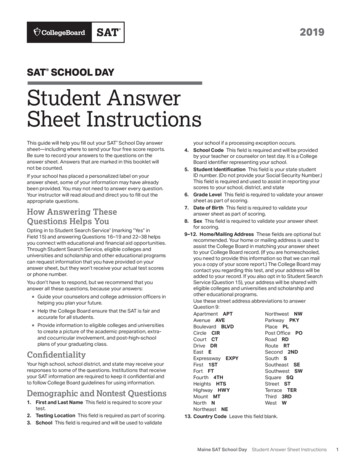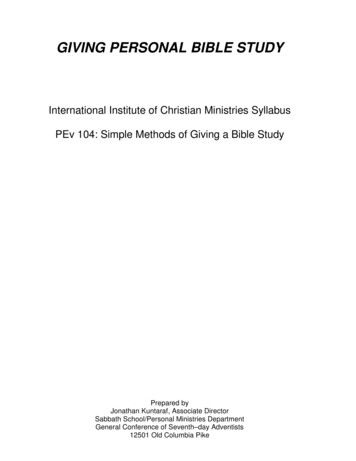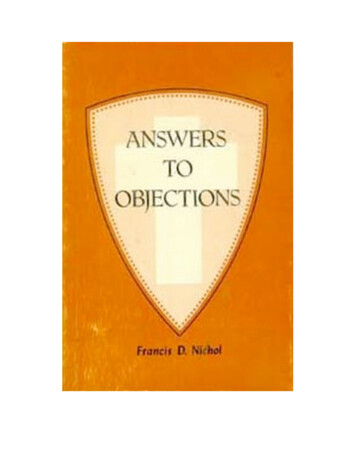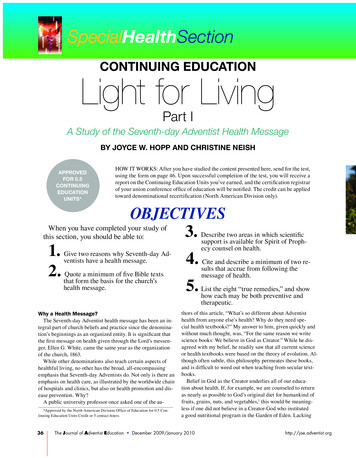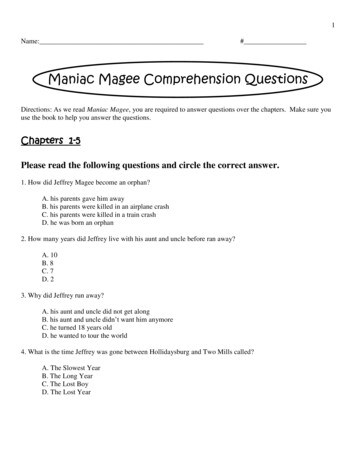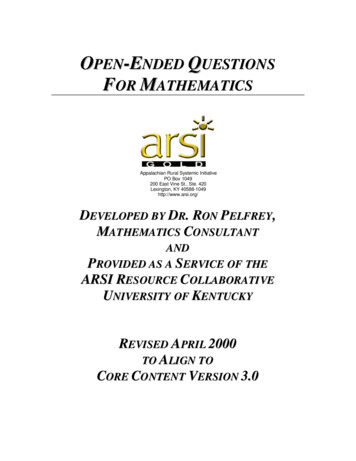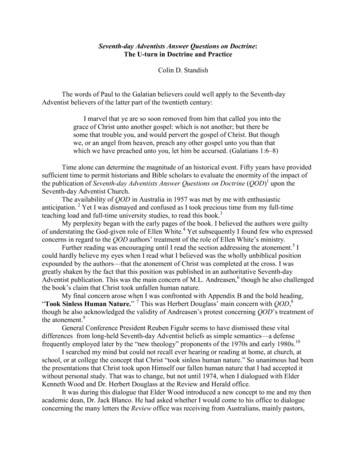
Transcription
Seventh-day Adventists Answer Questions on Doctrine:The U-turn in Doctrine and PracticeColin D. StandishThe words of Paul to the Galatian believers could well apply to the Seventh-dayAdventist believers of the latter part of the twentieth century:I marvel that ye are so soon removed from him that called you into thegrace of Christ unto another gospel: which is not another; but there besome that trouble you, and would pervert the gospel of Christ. But thoughwe, or an angel from heaven, preach any other gospel unto you than thatwhich we have preached unto you, let him be accursed. (Galatians 1:6–8)Time alone can determine the magnitude of an historical event. Fifty years have providedsufficient time to permit historians and Bible scholars to evaluate the enormity of the impact ofthe publication of Seventh-day Adventists Answer Questions on Doctrine (QOD)1 upon theSeventh-day Adventist Church.The availability of QOD in Australia in 1957 was met by me with enthusiasticanticipation. 2 Yet I was dismayed and confused as I took precious time from my full-timeteaching load and full-time university studies, to read this book.3My perplexity began with the early pages of the book. I believed the authors were guiltyof understating the God-given role of Ellen White.4 Yet subsequently I found few who expressedconcerns in regard to the QOD authors’ treatment of the role of Ellen White’s ministry.Further reading was encouraging until I read the section addressing the atonement.5 Icould hardly believe my eyes when I read what I believed was the wholly unbiblical positionexpounded by the authors—that the atonement of Christ was completed at the cross. I wasgreatly shaken by the fact that this position was published in an authoritative Seventh-dayAdventist publication. This was the main concern of M.L. Andreasen,6 though he also challengedthe book’s claim that Christ took unfallen human nature.My final concern arose when I was confronted with Appendix B and the bold heading,“Took Sinless Human Nature.” 7 This was Herbert Douglass’ main concern with QOD,8though he also acknowledged the validity of Andreasen’s protest concerning QOD’s treatment ofthe atonement.9General Conference President Reuben Figuhr seems to have dismissed these vitaldifferences from long-held Seventh-day Adventist beliefs as simple semantics—a defensefrequently employed later by the “new theology” proponents of the 1970s and early 1980s.10I searched my mind but could not recall ever hearing or reading at home, at church, atschool, or at college the concept that Christ “took sinless human nature.” So unanimous had beenthe presentations that Christ took upon Himself our fallen human nature that I had accepted itwithout personal study. That was to change, but not until 1974, when I dialogued with ElderKenneth Wood and Dr. Herbert Douglass at the Review and Herald office.It was during this dialogue that Elder Wood introduced a new concept to me and my thenacademic dean, Dr. Jack Blanco. He had asked whether I would come to his office to dialogueconcerning the many letters the Review office was receiving from Australians, mainly pastors,
2hostile to the special righteousness by faith issue of the Review and Herald. His assertion duringthis dialogue was that the basis of the opposition to the message of character perfection wasrooted in their belief that Christ took unfallen human nature. Until that day, I had not linked thetwo issues together, even though I had not wavered in my belief in the fallen human nature ofChrist on the one hand and the power of Christ to enable fallen humans to gain victory overevery temptation of Satan on the other hand.The Role of Sister Ellen White in the Seventh-day Adventist ChurchI was already aware that the prophetic role of Sister White was not fully accepted amongSeventh-day Adventists. I heard that many in Western Europe were weak or skeptical regardingthe divine origin of Sister White’s writings.11 I had heard of “California Adventists” 12 wholikewise were skeptical of the validity of Sister White’s writings. However, early in the pages ofQOD I was aroused by what appeared to be a casual comment; its inclusion, however, made nolittle impact upon me. The sentence, which introduced a quotation by Sister White, simply stated,“Ellen G. White, one of our leading writers, wrote in 1892. . . .” 13 Then followed a Spirit ofProphecy quotation.I wondered, “What were the authors attempting to convey to the readers?” This was amajor concern to me. It seemed that the authors portrayed Sister White as occupying no specialrole in our midst. It was hardly better when the QOD authors wrote, “This has been wellexpressed by one of our most prominent writers, Ellen G. White.” 14Of the questions posed by the evangelicals to the representatives of the Seventh-dayAdventist Church, question 9 set forth in QOD directly addressed the role of Sister White:Do Seventh-day Adventists regard the writings of Ellen G. White as onan equal plane with the writings of the Bible? Do you place her in theprophetic class with such men as Isaiah, Jeremiah, Ezekiel, and Daniel?Are her interpretations of Bible prophecy regarded as final authority, andis belief in these writings made a test of fellowship in the Seventh-dayAdventist Church? 15Some of the initial answers to these questions by the authors of QOD appeared to beevasive. Below are their short answers:“1. That we do not regard the writings of Ellen G. White as an addition to the sacredcanon of Scripture.“2. That we do not think of them as of universal application, as is the Bible, butparticularly for the Seventh-day Adventist Church.“3. That we do no regard them in the same sense as the Holy Scriptures, which standalone and unique as the standard by which all other writings must be judged.” 16Let us evaluate the answers of the authors of QOD.1.In their 3-point summary answer, the writers of QOD avoided the part of the firstquestion of the evangelicals by not addressing whether Sister White’s writings wereregarded as on an “equal plane” with the writings of the Bible. From their fuller answers,here is a portion of their reply:
3We have never considered Ellen G. White to be in the same categoryas the writers of the canon of Scripture. (QOD, p. 90)While Adventists hold the writings of Ellen G. White in highestesteem, yet these are not the source of our expositions. . . . We as adenomination accept them as inspired counsels from the Lord. But wehave never equated them with Scripture as some falsely charge. (Ibid., p.93)2.I was amazed at the second answer provided to the evangelicals. How could theauthors of QOD assert that Sister White’s writings are not of universal application?Certainly much of the writings of Ellen White have universal application? 17 Certainlysome of the Bible writings are not of general universal application.18 The Bible and theSpirit of Prophecy each set forth both individualized counsel with limited application andalso transcendent universal truths. Also, this second point in the response of the authorsof QOD clearly implied that Sister White’s books have little if any application to thosenot of our faith. Yes, many books provide special counsel specifically to Seventh-dayAdventists leaders and members, yet Sister White wrote many books especially preparedfor those not of our faith.193.Seventh-day Adventists certainly believe that the canon of Scripture is closedwith the New Testament and the Bible is our foundation of all faith and practice.However, we believe that Sister White was inspired by the same Holy Spirit whichinspired the prophets and writers of the Holy Bible, including Isaiah, Jeremiah, Ezekiel,and Daniel. This question was ignored in the initial summary response. However, here istheir later response:We have never considered Ellen G. White to be in the same categoryas the writers of the canon of Scripture. However, apart from the chosenwriters of the canonical books of Scripture, God used a line of prophets ormessengers who lived contemporaneously with the writers of the twoTestaments, but whose utterances were never a part of Scripture canon.These prophets or messengers were called of God to give encouragement,counsel, and admonition to the Lord’s ancient people. Among these weresuch figures as Nathan, Gad, Heman, Asaph, Shemaiah, Azariah, Eliezer,Ahijah, Iddo, and Obed in the Old Testament, and Simeon, John theBaptist, Agabus, and Silas in the New. The line also included women,such as Miriam, Deborah, and Huldah, who were called prophetesses, inancient times, as well as Anna in the time of Christ, and Philip’s fourdaughters, “which did prophesy” (Acts 21:9). The messages that camethrough these prophets, it should be recognized, came from the same Godwho spoke through those prophets whose writings were included in theSacred Canon. . . .It is in this latter category of messengers that we consider Ellen G.White to be. . . .While Seventh-day Adventists recognize that the Scripture canonclosed nearly two thousand years ago and that there have been no
4additions to this compilation of sacred books, yet we believe that the Spiritof God, who inspired the Divine Word known to us as the Bible, haspledged to reveal Himself to the church through the different gifts of theSpirit.Adventists believe that the closing of the Scripture canon did notterminate Heaven’s communication with men through the gifts of theSpirit, but rather that Christ by the ministry of His Spirit guides Hispeople, edifying and strengthening them, and especially so in these lastchallenging days of human history. (QOD, pp. 90-95)There is no doubt that the authors of QOD improved upon their earlier statementsconcerning the role of Sister White. However, she is presented in a category inferior to the majorprophets of the Bible. Even John the Baptist’s prophetic role seems marginalized, no doubtbecause he did not contribute to the canon of Scripture. I believe wisdom dictates that we darenot seek to categorize the greatness of prophets. Let us simply confirm that the undoubtedprophetic utterances of Ellen White are inspired by the Holy Spirit and are a great blessing to thechurch and to the world.The authors of QOD correctly pointed out that all the pillars of our faith are riveted in HolyScripture. Yet we believe Sister White was given inspired truths which are of universal application forour time. For example, that germs cause cancer,20 that tobacco is a malignant poison,21 thatmasturbation can cause mental illness,22 that progressive dietary reform should be made towardveganism.23 In each of these health warnings Sister White was far ahead by many decades of scientificmedical research, and this counsel has proven to be applicable to all humans worldwide.In other areas she presented broad principles for Seventh-day Adventists, such as thecounsel that we should not vote for political parties 24 and that competitive sports are not fitactivities for Christians.25 It appears the authors tried to minimize the role of Sister White.4.The QOD authors also leave much ambiguity in their answer to the third questionof the evangelicals. Have we ever made belief in the Spirit of Prophecy a test offellowship? I have not found any authoritative statement which declares that theacceptance of the Spirit of Prophecy is a test of continued fellowship in the Seventh-dayAdventist Church. However, we have made belief in the Spirit of Prophecy a part of ourbaptismal vows which we affirm before baptism and are accepted into churchmembership. Indeed, in the 1951 baptismal vows this was so. These were the currentvows when QOD was written, and this vow did not change until 1985 when it wasultimately modified at the General Conference session of that year and was presented inthe revised Church Manual of 1986 and has remained there to the time of thispresentation.26 The 1951 baptismal vow number 8 stated,Do you accept the doctrine of spiritual gifts and do you believe that theSpirit of Prophecy is one of the identifying marks of the remnant church?There is a great difference between the terms “the gift of prophecy” and “the Spirit ofprophecy,” for we can ignore Ellen White or have no knowledge of her inspired counsels and yetaffirm the gift of prophecy.
5Nowhere in Scripture is God’s remnant identified by the term “the gift of prophecy.” Wemust never forget that God’s end-time remnant saints are identified as those who “keep thecommandments of God and have the testimony of Jesus Christ” which is “the Spirit ofProphecy.” (Revelation 12:17; 19:10.) Neither must we ever forget that the Seventh-dayAdventist Church is not just another church among the multitude of churches in Christendom. Itis God’s remnant church which He has raised up and commissioned to take the everlastinggospel of the three angels’ messages to every creature (Mark 16:15) on the planet prior to thereturn of our blessed Lord and Savior.The Completed AtonementIn his introduction to Seventh-day Adventists Answer Questions on Doctrine: AnnotatedEdition (QODAE), Dr. George Knight offered a surprising evaluation of the QOD authors’conclusion concerning the completed atonement. He had correctly evaluated that the QODauthors’ stated position concerning the humanity of Jesus represented “a substantial shift inunderstanding” from that of the preponderance of Seventh-day Adventists from the church’sbeginning,27 who believed that Christ took upon Himself our fallen, sinful human flesh (nature).However I cannot support Knight’s assertion that “. . . the supposed shift of position onthe atonement [by the QOD authors as claimed by M.L. Andreasen] was incorrect.” 28 IndeedAndreasen’s assertion was fully consistent with the evidence.Andreasen’s doctrinal position was that which had been taught by Seventh-day Adventistsfrom early times. This position was that the sacrificial phase of the atonement was completed onCalvary by the death and spilt blood of Jesus, but the atonement of Christ would not becompleted until after Jesus, as our ministering heavenly High Priest, sprinkled His blood on themercy seat in the Holy of Holies. The Bible was the foundation for this conclusion 29 and wasuniformly supported by the Spirit of Prophecy.30I can attest that from my earliest understanding—and without any recalled exceptions—that I was consistently taught by teachers, pastors, and evangelists that the atonement of Christwas not completed on the cross. Beyond this, I had found the Bible and the Spirit of Prophecy tobe rock solid on this teaching.Knight appears not to have noticed that the authors of QOD had been careless, selective,or maybe not wholly transparent in their response to question 30 proposed by the evangelicals:“Seventh-day Adventists are frequently charged with minimizing theatoning sacrifice completed at the cross, reducing it to an incomplete orpartial atonement that must be supplemented by Christ’s priestly ministry;perhaps it might be called a dual atonement. Is this charge true? Does notMrs. White state that Christ is now making atonement for us in theheavenly sanctuary? Please explain your position, and state wherein youdiffer from others on the atonement.” 31In response, Froom et al. referred to a statement from Early Writings:The great Sacrifice had been offered and had been accepted, and the HolySpirit which descended on the day of Pentecost carried the minds of the
6disciples from the earthly sanctuary to the heavenly, where Jesus had enteredby His own blood, to shed upon His disciples the benefits of His atonement. 32When taken in isolation, this statement appears to support, at least partially, the claim ofthe QOD authors, thatWhen, therefore, one hears an Adventist say, or reads in Adventistliterature—even in the writings of Ellen G. White—that Christ is makingatonement now, it should be understood that we mean simply that Christ isnow making application of the benefits of the sacrificial atonement Hemade on the cross; that He is making it efficacious for us individually,according to our needs and requests. Mrs. White herself, as far back as1857, clearly explained what she means when she writes of Christ’smaking atonement for us in His ministry: [Then Early Writings, p. 260,was quoted as shown above.] 33Yet it defies credibility to believe that the authors of QOD had overlooked the plainstatements a few pages earlier in Early Writings in which Sister White taught that the atonementwas completed not on the cross but in the holy of holies of the heavenly sanctuary:As the priest entered the most holy once a year to cleanse the earthlysanctuary, so Jesus entered the most holy of the heavenly, at the end of the2300 days of Daniel 8, in 1844, to make a FINAL ATONEMENT for allwho could be benefited by His mediation, and thus to cleanse thesanctuary. 34The minds of all who embrace this message are directed to the mostholy place, where Jesus stands before the ark, making HIS FINALINTERCESSION for all those for whom mercy still lingers and for thosewho have ignorantly broken the law of God. This ATONEMENT ISMADE for the righteous dead as well as for the righteous living. Itincludes all who died trusting in Christ, but who, not having received thelight upon God’s commandments, had sinned ignorantly in transgressingits precepts.35Knight argues that Froom’s statement in his February 1957 Ministry article (“That is thetremendous scope of the sacrificial act of the cross—a complete, perfect, and final atonement forman’s sin.”) really meant “. . . the sacrifice on the cross was a full and complete sacrifice (interms of the sacrificial aspect of the atonement) for sin.” 36In the light of Ellen White’s statements in Early Writings, pp. 253, 254, I find thisexplanation overgenerous. If Froom overlooked the wrong impression many would draw fromhis statement, surely a copyeditor would flag the statement. Is there evidence that Froom made acorrection in a future Ministry issue? I am not aware of such a correction or clarification. SurelyAndreasen’s words were “prophetic”:
7If the book [QOD] is published, there will be repercussions to the end ofthe earth that the foundations [of Adventist theology] are being removed.” 37Some suggested, uncharitably, that Andreasen’s opposition was motivated by the fact thathe had been ignored in the dialogues and in the review of the QOD manuscript. Elder Figuhrcertainly ignored or rejected Andreasen’s plea to reconsider the statement that the atonement wascompleted by Christ’s sacrifice. Some critics of Andreasen make much of Andreasen’s change toa statement Froom made in the February issue of the Ministry magazine.38 This change, I believe,was inconsequential to Froom’s meaning.Neither does it seem possible that the QOD authors had overlooked the clear expositionof some of the most notable writers in the ranks of the Seventh-day Adventist Church such asJames White, Uriah Smith, and Stephen Haskell.39 The explanation that seems most credible tome is that the authors and their main advisors, including the then General Conference President,Elder Reuben Figuhr, were so consumed in their desire to save the Seventh-day AdventistChurch from the stigma of the label “cult” that they were ready to reshape pillar beliefs of theSeventh-day Adventist Church to gain favor with these prominent evangelicals.While I do not overlook the splendid answers to many questions including the state of thedead, the seventh-day Sabbath, the law of the ten commandments, the second coming, andprophetic interpretations, it is of the utmost importance to understand that Barnhouse and Martinhad narrowed down their “tests” as to whether the Seventh-day Adventist Church was a cult tojust four areas—(1) that the atonement of Christ was not completed upon the cross; (2) thatsalvation is the result of grace plus the works of the law; (3) that the Lord Jesus was a createdbeing, not existing from eternity; and (4) that He partook of man’s sinful fallen nature at theincarnation.40 We can only continue to wonder why Barnhouse and Martin limited their test tothese four questions. No doubt, long before QOD was published, Barnhouse and Martinunderstood that questions two and three did not pose any significant difference between theirbeliefs and those of Seventh-day Adventists.41The second “test” imposed by Barnhouse and Martin was easily demonstrated to be falseby valid evidence. While we cannot deny that there have been Seventh-day Adventists who haveplaced merit in law-keeping in their explanation of salvation, those who are thoroughly Biblebased Seventh-day Adventists have stood unwaveringly upon the plain words of Scripture 42 andthe Spirit of Prophecy.43 Keeping the law or good works are neither the basis of salvation nor dothey provide merit toward salvation. However, they are the inevitable result of God’s savinggrace and power in the heart of the converted man. The presentation of Dr. Elliot Waggoner atthe 1888 General Conference session in Minneapolis, fervently supported by Ellen White, was toslowly but surely redress any earlier presentations by some Seventh-day Adventists whichinferred that there was merit toward salvation in law keeping or good works.Further, the third “test” was just as easily answered. Once again we have had in our ranksthose who deny the eternal deity of Christ even to this day, and certainly included were some ofour prominent pioneers including James White, J.H. Waggoner, Uriah Smith, Joseph Bates, J.N.Loughborough, and D.M. Canright.44 However, especially after the publishing of the Desire ofAges in 1898, we have had overwhelming support for the eternal existence of Christ in the Spiritof Prophecy.45 These statements fully support the Bible.46The first and fourth “tests” posed valid challenges to long-held Seventh-day Adventistdoctrines. Overwhelmingly, Seventh-day Adventists prior to 1957 believed that, while thesacrifice of Christ on the cross was fully sufficient to pay the penalty for our sins, Christ’s work
8of atonement is to be completed in the most holy place of the heavenly sanctuary. It appears thatthe authors of QOD wilted under the withering pressure of the evangelicals, and they failed thetest on each of these two issues. As I have presented above, the completed atonement in theheavenly sanctuary is based upon sound Biblical evidence. If the atonement was completed onthe cross, Paul’s statement to the Corinthians would be erroneous (1 Corinthians 15:17, 18) 47 forit certifies that those who die “in Christ” would perish [eternally] if Christ was not raised fromthe dead. Christ had to be raised to complete the atonement in the heavenly sanctuary. The fourthtest, regarding the fallen, sinful human nature of Christ, is also riveted in sound Biblicalevidence, as I will address later in this paper.To argue that Froom and others did not tamper with cardinal beliefs of our church isimpossible to defend validly. Certainly Barnhouse was not deceived. Here are his words:The position of the Adventists seems to some of us in certain cases tobe a new position; to them it may be merely the position of the majoritygroup of sane leadership which is determined to put the brakes on anymembers who seek to hold views divergent from that of the responsibleleadership of the denomination. 48Other Evangelicals also perceived these changes.49In the same (September 1956) issue of Eternity magazine, those who remained steadfastin the faith established from the Bible in our church’s earlier history were defamed by thevitriolic language of Dr. Barnhouse. He stated that these loyal Seventh-day Adventists werethose “. . . among their numbers [who were] of their ‘lunatic fringe.’ ” 50 Both Donald Barnhouseand Walter Martin were men of caustic tongues. Knight referred to Barnhouse’s vitriolicresponse to those who disagreed with him.51 The experience of Dr. and Mrs. Kern Pihl, when Dr.Barnhouse was questioned during his speaking tour of Peru in late 1959, was indicative of hishatred of the Sabbath. “In the name of Jesus Christ, I curse the Seventh-day Sabbath.” 52The aggressive challenge to Dr. William Johnsson by Walter Martin on the Ankerbergprograms in 1985 over the role of Sister White as the “Adventist guru” was evidence of Martin’saggressiveness. Yet the loyalty by Froom et al. to these evangelicals was amazing. In whatproved to be my last conversation with Elder Roy Allan Anderson in the San Bernardino mall inthe early 1980s, Elder Anderson vigorously defended Walter Martin as a “great friend” of theSeventh-day Adventist Church.Yet it was Elder Anderson who made it plain that the real purpose of Questions onDoctrine was a planned attempt to reshape the beliefs of our church. This was revealed in a letterto Pastor Robert Greive, (president of the North New Zealand Conference in the 1950s) who leftthe faith. He was dismissed from his position and disfellowshipped from the church forpreaching evangelical beliefs. It was Elder Anderson, a friend of Greive, who tried “to savehim.” Here is what Anderson wrote to Pastor Greive. This letter is evidence that Elder Andersonrecognized that the authors of QOD were seeking to reposition certain long-held beliefs of theSeventh-day Adventist Church.If you would suffer me this little word of counsel as a friend, I wouldsuggest that you hold those thoughts in your heart and not make an issueof them until we, as a people, come to the place where we understand thedoctrine as clearly as we should, and as we do other points of our faith. . . .
9I am confident that the time is near when the great mystery of godlinesswill be understood better by us as a people. But until then it would seemwise if we could confine ourselves to a prayerful discussion of it betweenus as workers.53The Humanity of ChristThe uniquely divine-human nature of the incarnate Christ was not in question in theissues raised in QOD. The issue was, What human nature did Christ take upon Himself? 54 Dr.Ralph Larson’s monumental book, The Word Was Made Flesh 55 provides the definitive researchrevealing how Seventh-day Adventist authors and writers in the English-speaking world wereunified upon the belief that Christ took upon Himself man’s fallen human nature.Dr. Ralph Larson was one of the most perceptive scholars from the 1970s, prominent inhis courageous stand against QOD and its authors. Larson’s articulate pen was exercised withforceful impact, even late in his life. These extracts from an article published in 2004 reflectedthree decades of deep concern over the misrepresentations of the Seventh-day Adventist faith inQOD.56Larson presented about 1,200 quotes from periodicals and other sources in NorthAmerica, Great Britain, South Africa and Australasia. About 400 of these quotes were fromEllen White. This tome offers unchallengeable evidence which supports George Knight’sassessment that QOD’s heading “Took Sinless Human Nature” “implies that that was EllenWhite’s idea when in fact she was quite emphatic in repeatedly stating that Christ took ‘oursinful nature’ and that ‘He took upon Himself fallen, suffering human nature, degraded anddefiled by sin.’ ” 57 Larson uncovered not one Seventh-day Adventist writer before 1952 whowrote other than that Christ took upon Himself our fallen, sinful nature. 58 He also demonstratedthat, over a period of almost sixty years, Sister White did not waver in her position that Christtook upon Himself our fallen, sinful nature. 59That bold QOD heading, “[Christ] Took Sinless Human Nature” certainly removes anycredibility from General Conference President Reuben Figuhr’s assertion that, while QODpresented the Seventh-day Adventist beliefs in language understood by evangelicals, “there hasbeen no attempt to gloss over our teachings or to compromise.” 60 This heading was a denial ofthe plain truths taught in the Bible and the Spirit of Prophecy—that Christ took fallen, sinfulhuman nature.One of the most significant findings in Larson’s book is that one of the primary authors ofQOD had, just a few years before the publication of QOD, affirmed that Christ took fallenhuman flesh. This is what Elder W.E. Read approvingly quoted from Sister White at the 1950General Conference, “Jesus was in all things made like unto His brethren. He became flesh evenas we are.” 61When I was president of Columbia Union College, I was a colleague of Elder FentonFroom, the son of Elder Leroy Froom. It is of some significance that Elder Fenton Froom alsohad in print proclaimed Christ’s fallen human nature.62One of the most disturbing revelations is Dr. Herbert Douglass’ declaration that “Froomtook a poll of Adventist leaders and discovered that ‘nearly all of them’ felt that Christ had oursinful nature.” 63 Yet George Knight reports that the authors told Martin that “ ‘the majority ofthe denomination had always held’ the human nature of Christ ‘to be sinless, holy, and perfectdespite the fact that certain of their writers have occasionally gotten into print with contrary
10views completely repugnant to the church at large.’ ” 64 These writers “who occasionally” gotinto print confirming the fallen human nature of Christ, were categorized as part of the “lunaticfringe” by the authors of QOD.65 Many happened to be General Conference presidents, churchleaders, editors of the Adventist Review and Sabbath Herald, major authors and well-knowncollege teachers. Larson has fully documented many scores of these writers. My personal limitedresearch has failed to discover any exceptions to Larson’s research.However the reason that the great majority of Seventh-day Adventists then believed thatChrist took upon Himself fallen human nature was because they found that this was affirmed inholy Scripture.66 The most definitive text to explain why Christ took fallen human nature isfound in Hebrews 2:9, 14:But we see Jesus, who was made a little lower than the angels for thesuffering of death, crowned with glory and honour; that he by the grace ofGod should taste death for every man
Seventh-day Adventists Answer Questions on Doctrine: The U-turn in Doctrine and Practice . to read this book.3 My perplexity began with the early pages of the book. I believed the authors were guilty
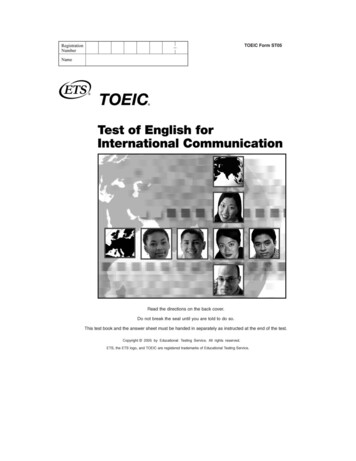
![Welcome [dashdiet.me]](/img/17/30-day-weight-loss-journal.jpg)
